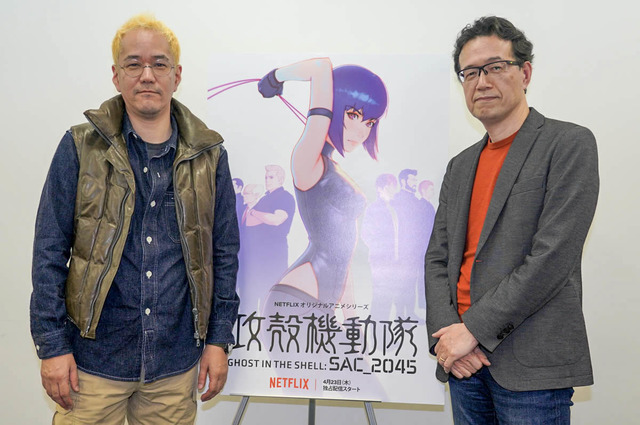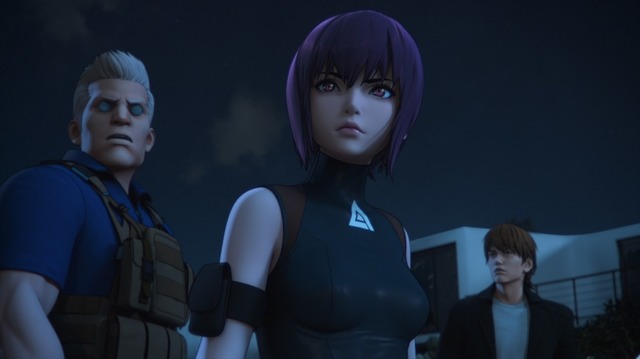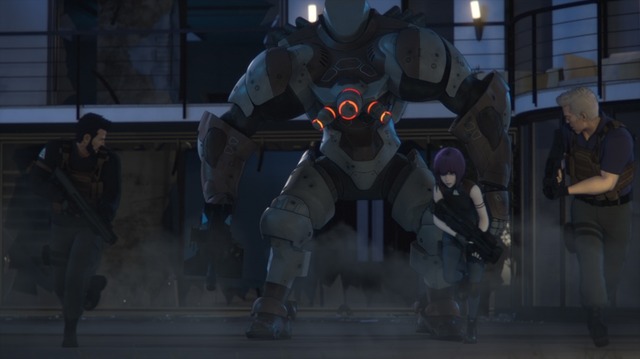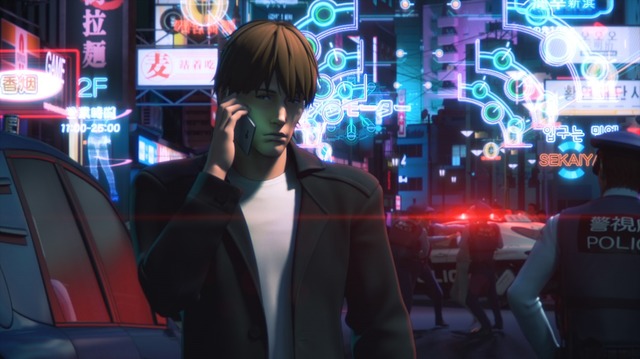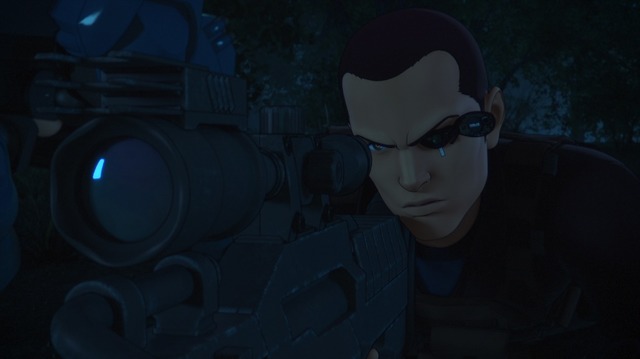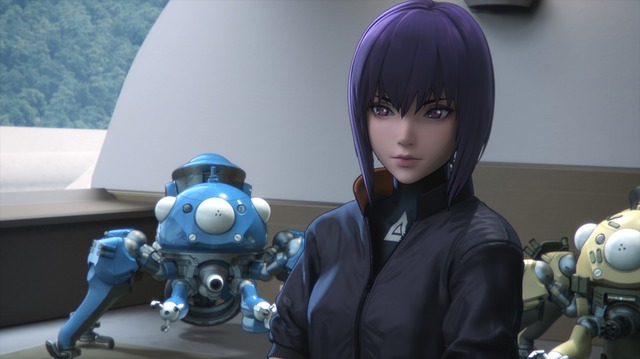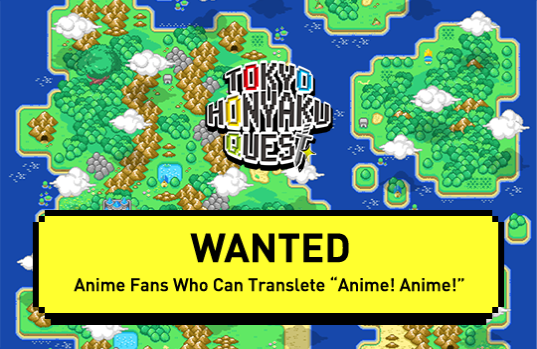“Ghost in the Shell: SAC_2045” premiers worldwide on Netflix on Thursday, Apr. 23.
The first full 3DCG anime of the series is the beginning of a new “Ghost in the Shell”. “Ghost in the Shell” is a monumental title of near-future Sci-Fi, which with its mindblowing world and visuals, has had a great impact on not only the viewers but also the creators.
Here at Anime!Anime!, we had an interview with the two directors of this show, Kamiyama Kenji and Aramaki Shinji.
The two directors teamed up on “ULTRAMAN”, the Netflix anime series that had the most views in Japan in 2019. What do they aim to show in the latest “Ghost in the Shell” series? Also, how did the 3DCG affect the title?
A new story, a new “Ghost in the Shell”… The latest title has “new” as a keyword.
We asked what the fans from the earlier series should check out.
[Interview and writing by Tanaka Shinobu]
■Why Depict “Ghost in the Shell” Set in 2045?
――The series is set in 2045. What made you depict “Ghost in the Shell” set in 2045, in this era?
Kamiyama: One of the reasons we put 2045 in the title is the “Singularity”.
When the project began, this word was drawing much attention. People were saying, “AI will be superior to the human race by 2045,” or “A world that no one has ever imagined is coming.”
It was a topic the “Ghost in the Shell” series couldn't avoid, so we decided to set the story in that period.
I myself wasn't trying to predict the future. I thought by digging into the idea will give us a further perspective of what would happen after the “Singularity”.
In a way, I'm depicting the “present” in the “Ghost in the Shell” world.
Aramaki: 2045 is the specific year we chose, but it is merely a symbol.
We are not trying to show people, “What the world would be in 25 years.”
――”Ghost in the Shell” is full of Sci-Fi elements such as “Cyborgs” and “Cyberbrains”. How did you connect these elements with the real-life modern world?
Kamiyama: We put smartphones into people's brains.
Aramaki: Since we're in an era of smartphones, we thought it would be very convincing. We aimed to make the settings easy to understand, so putting a smartphone in the brain would be pretty self-explanatory.
――I believe that the real world now has more in common with the “Ghost in the Shell” world than it used to. As directors, has it become easier to depict a Sci-Fi world?
Kamiyama: Not at all. In fact, some elements are even more difficult to depict, haha.
Aramaki: I agree. It's become easier to understand, but more difficult to make the story convincing.
For example, we used to stretch our imagination about “Cyberbrain”, but now, we need explanations for things like, “Where is it connected? Why is it disconnected?” or “What kind of technology do they use to communicate?”
――I see. What else do you take into consideration of depicting Sci-Fi?
Kamiyama: One example would be the city Togusa goes to in the 1st episode.
60% of the city is AR billboards. Everyone can see them, but he turns them off because their annoying.
In the other scenes, they were only shown in first-person views, but we decided to put them in the objective view too for that specific scene.
There's a scene in episode 1 where Motoko has an apple in her hand. She sees a tag on it, and it actually does have a tag.
However, we don't show the tag in the objective view.
Aramaki: We only show the tag from Motoko's point of view.
People with the app can see it, but the ones that don't can't. It's a very minor detail, but we were very strict about it.
Kamiyama: You won't notice it in a glance, but we carefully followed that rule.
Like the lady at the shop in episode 3 waves her hand as if she's trying to get rid of a fly.
She's doing this from the 1st episode. Basically, it's because, “A cheap Cyberbrain shows a lot of adds.”
――So it's like those ads that pop up on your screen.
Aramaki: Exactly. Sometimes you click on them by mistake when trying to clear them. She's trying to get rid of those ads.
――That's another representation of the inequality of media literacy.
Aramaki: You can get rid of them by paying extra, just like in our world.
Kamiyama: If you have the skills to not see them, you won't. The people without media literacy for such technology are deprived of their time and data. We wanted to depict such a world in the earlier episodes.
Aramaki: Another example would be the scene where an elderly man is withdrawing money from a bank. He has to enter codes, but Batou only has to walk by the console.
That's the details we were very precise about.
→Next Page: 3DCG in Sci-Fi
■3DCG in Sci-Fi
――One of the greatest features of this anime is that it is “Full 3DCG”. Did the 3DCG help you depict something you couldn't in 2D designs?
Kamiyama: That would be the depiction of the difference between “Cyborg Humans”, “Flesh-and-blood Humans”, and “Androids”.
There's a limit in how much you can show the contrast in 2D. We tried things like, “Cyborgs are heavier so the ground breaks when they jump down,” and “They don't flinch when shooting a gun,” but not everyone notices those depictions, haha.
――I see. How does 3DCG help you depict the differences?
Kamiyama: In cell animation, both humans and cyborgs have that moment of pause.
However, 3DCG uses motion capture, so there are no pauses.
Cyborg humans and flesh-and-blood humans do not completely stay still, but for example, the reception androids at companies will be motionless when they're in standby. They start moving when people come by.
You will now that this is an android just by watching the image.
On the contrary, Motoko is almost a complete cyborg, but looks just like a flesh-and-blood human.
However, she is a bit too smooth, overly well balance, and she doesn't get fat.
She looks young, but how could such a young girl be the captain of a squad of hefty men? That's how you know that inside, she's not a young girl, making it obvious that her looks are artificial.
■A Change in The Character Design
――Please tell us about the character designs. Especially, Motoko seems to have changed her appearance from the former series.
Kamiyama: We decided to renew it and focused on it being 2045.
Though it is set 15 years later from the “Ghost in the Shell: Stand Alone Complex” series, we didn't want to show Motoko older. We wanted to make it a series that can be enjoyed by those who watch “Ghost in the Shell” for the first time.
Aramaki: We kept it fresh.
Kaimiyama: Motoko's proportion of her figure has changed, which makes her seem younger than the former series.
Actually, this is because of technical reasons, and in 3DCG, it's difficult to make her performance realistic with her initial body proportions.
In traditional animation, we can draw the characters' best fit for each scene, but in 3DCG, the models' sizes aren't flexible. We designed the characters on the basis of moving them as 3DCG models.
――Tell us about the overall looks of the 3DCG design. How is it different from “ULTRAMAN”, on which you also teamed up.
Aramaki: For “ULTRAMAN” we used a style called the “Cell Look”. However, for “Ghost in the Shell”, we gave them a different look to match the characteristics of the title. We discussed how each character should look.
Also, we were careful about their expressions. We don't want to miss the essence of the characters.
――What about the series mascot character, Tachikoma?
Kamiyama: Tachikoma has been in 3DCG from before, so there is not much of a difference in its depiction.
Aramaki: There are some minor changes in its design though. Especially the size. We wanted to make it smaller, so we shrunk it to a size that Batou could barely fit in.
――Why did you make it smaller?
Kamiyama: In drawings, we can “lie” in every scene, but in 3DCG the size will be displayed as-is. We thought making him big would cause trouble later on.
In the manga, there's a scene where Fuchikoma, the original of Tachikoma, hides inside a maintenance hole. But when you think about it, Tachikoma is bigger than a compact car. There's no way it will fit, haha.
Such scenes do work in mangas, but will be odd in 3DCG anime.
Aramaki: For instance, if Tachikoma is in this room, everyone is going to say, “How in the world did it get in here?!”, haha.
That's why we wanted to make it as small as possible.
Kamiyama: A new depiction of Tachikoma would be, when a cyborg is diving it, the virtual cockpit always projects the direction it's moving in in front, even when it's going in reverse.
A cyborg can switch its senses opposite so it can still drive. We tried these new expressions which we couldn't in the past.
――One more question. Tell us about what the fans from the previous “Ghost in the Shell” series should expect from this title.
Kamiyama: The “Ghost in the Shell” series has kept on going, and many incidents have been depicted in its universe. However, a world war making a historical change is something new to the series.
How Motoko and the members of Public Security Section 9 react to such a situation is quite interesting.
I hope people will watch in and say, “Oh, that's what they changed, but it's not completely different.”
Aramaki: Anything I say might become a spoiler, haha. The first half is the members of Public Security Section 9 re-assembling.
Please look forward to how they get back together.
Kamiyama: The fans who have watched the former series will probably be surprised.
Aramaki: I agree. There will be some surprising scenes, but don't forget to check out the introduction scenes too. We really got creative in them.
(C)Shirou Masamune・Production I.G / Kodansha・Ghost in the Shell 2045 Production Committee


